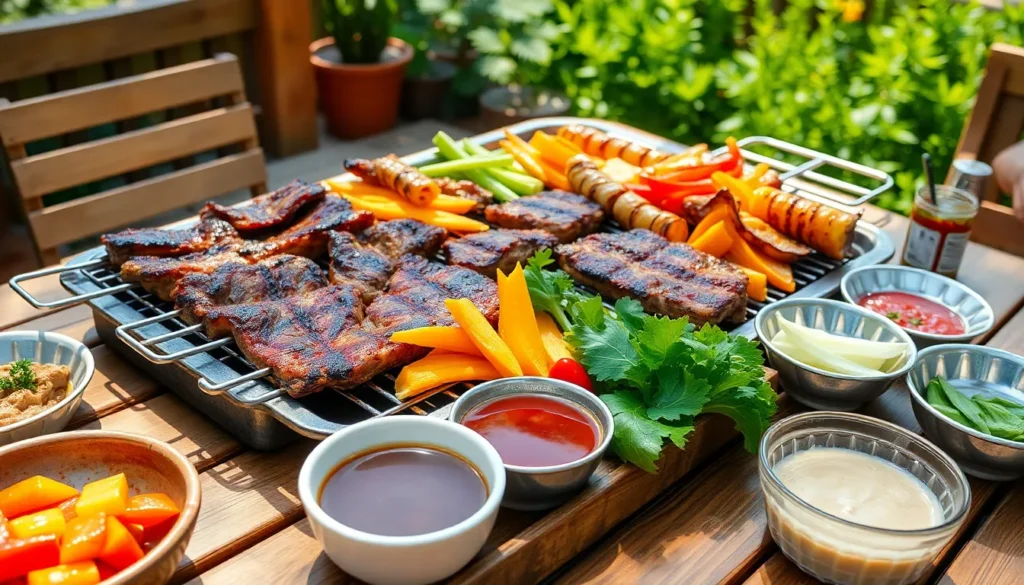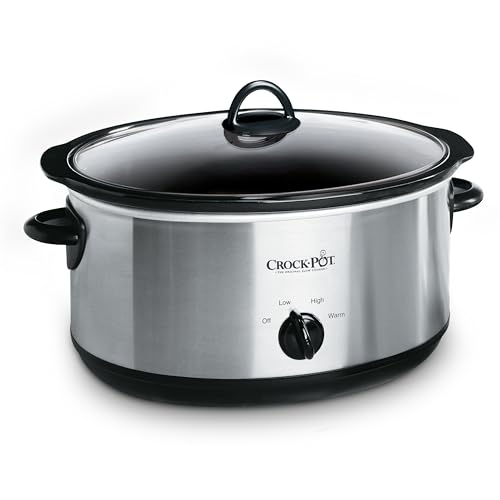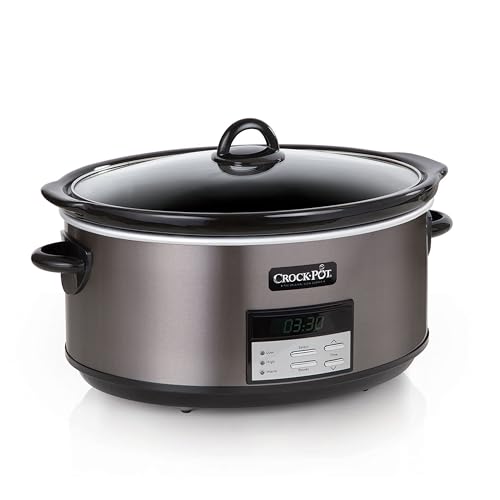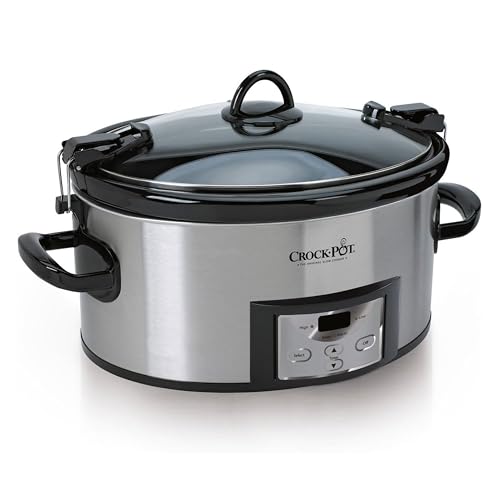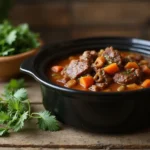We’ve all fallen in love with that perfect balance of sweet, savory, and slightly spicy flavors that make Korean BBQ so irresistible. The secret? It’s all in the sauce. While restaurant-quality Korean BBQ sauce might seem complex, we’re here to show you how simple it can be to create this magical condiment at home.
Our easy Korean BBQ sauce recipe uses pantry staples you probably already have on hand. No need for specialty trips to Asian markets or hard-to-find ingredients. In just 10 minutes, you’ll have a glossy, flavorful sauce that transforms ordinary grilled meats into something extraordinary.
Whether you’re planning a backyard BBQ, looking to jazz up weeknight dinners, or simply craving that authentic Korean flavor, this sauce delivers every time. It’s versatile enough to use as a marinade, glaze, or dipping sauce – making it your new go-to for adding serious flavor to any meal.
Ingredients
Our homemade Korean BBQ sauce requires just a handful of pantry staples that deliver authentic flavor without any specialty shopping. We’ve organized the ingredients into essential base components and optional enhancements to customize your sauce.
For the Base Sauce
- 1/2 cup soy sauce (low sodium preferred)
- 1/4 cup brown sugar (packed)
- 2 tablespoons rice vinegar
- 1 tablespoon sesame oil
- 3 cloves garlic (minced)
- 1 tablespoon fresh ginger (grated)
- 2 teaspoons gochujang (Korean chili paste)
- 1 tablespoon honey
- 1 teaspoon cornstarch
- 2 tablespoons water
For Optional Add-ins
- 1 Asian pear (grated, for natural sweetness)
- 1 green onion (finely chopped)
- 1 teaspoon toasted sesame seeds
- 1/2 teaspoon black pepper (freshly ground)
- 1 tablespoon mirin (for extra depth)
- 1/4 teaspoon red pepper flakes (for heat adjustment)
Equipment Needed
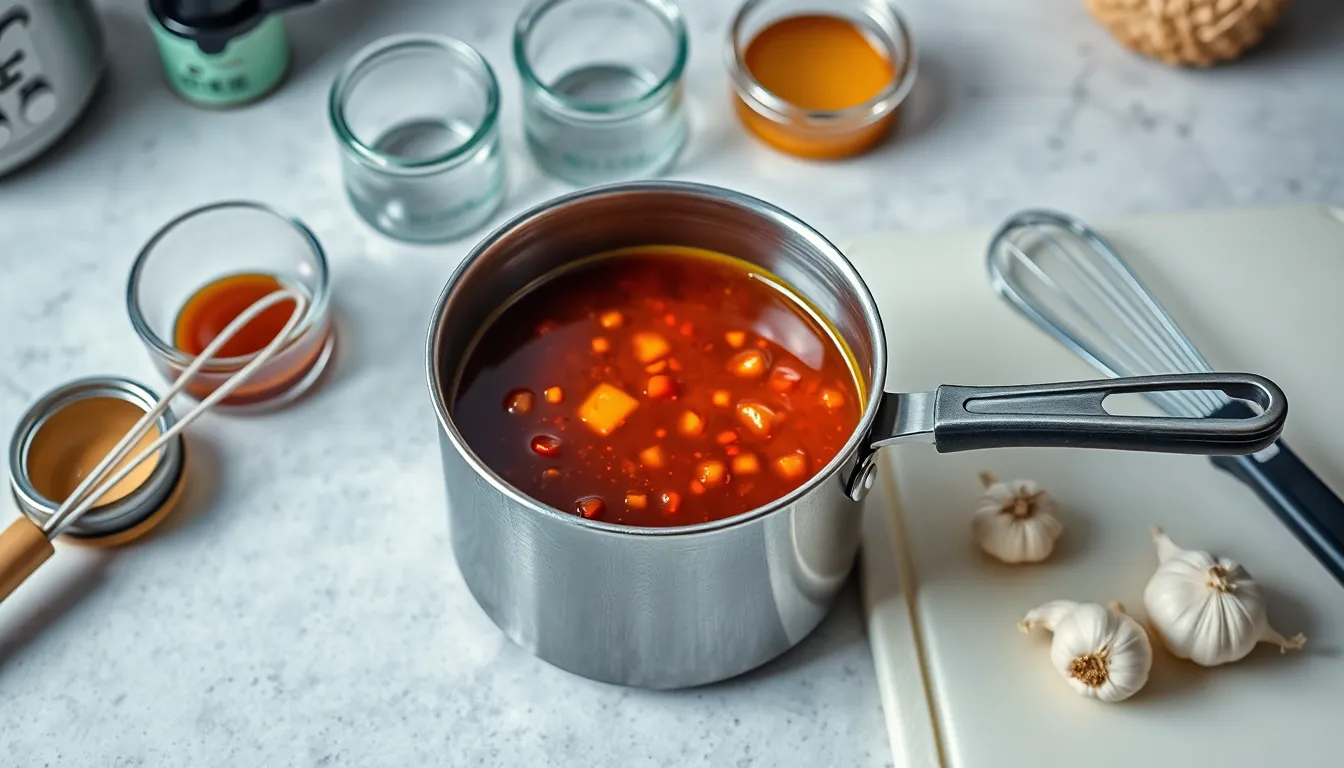
Creating our homemade Korean BBQ sauce requires minimal kitchen equipment that most home cooks already have on hand. We need a medium saucepan or small pot to heat and combine our ingredients effectively. This vessel should be large enough to accommodate stirring without spilling while the sauce simmers.
A whisk or wooden spoon serves as our primary stirring tool to blend the ingredients smoothly and prevent any lumps from forming. We recommend keeping both nearby since the whisk works best for initial mixing while the spoon handles the simmering phase better.
Standard measuring cups and spoons ensure accuracy in our ingredient ratios. These tools help us achieve the perfect balance of sweet, savory, and spicy flavors that define authentic Korean BBQ sauce.
A sharp knife paired with a cutting board becomes essential for mincing fresh garlic and grating ginger. Fresh aromatics make a important difference in the sauce’s final flavor profile compared to their dried counterparts.
We also need a small mixing bowl to create our cornstarch slurry. This separate vessel prevents lumps from forming when we add the thickening agent to our hot sauce mixture.
Finally, an airtight container or jar provides proper storage for our finished sauce. Glass jars work particularly well since they don’t absorb odors and allow us to see the sauce consistency at a peek. Proper storage equipment helps maintain freshness for up to one week in the refrigerator.
Instructions
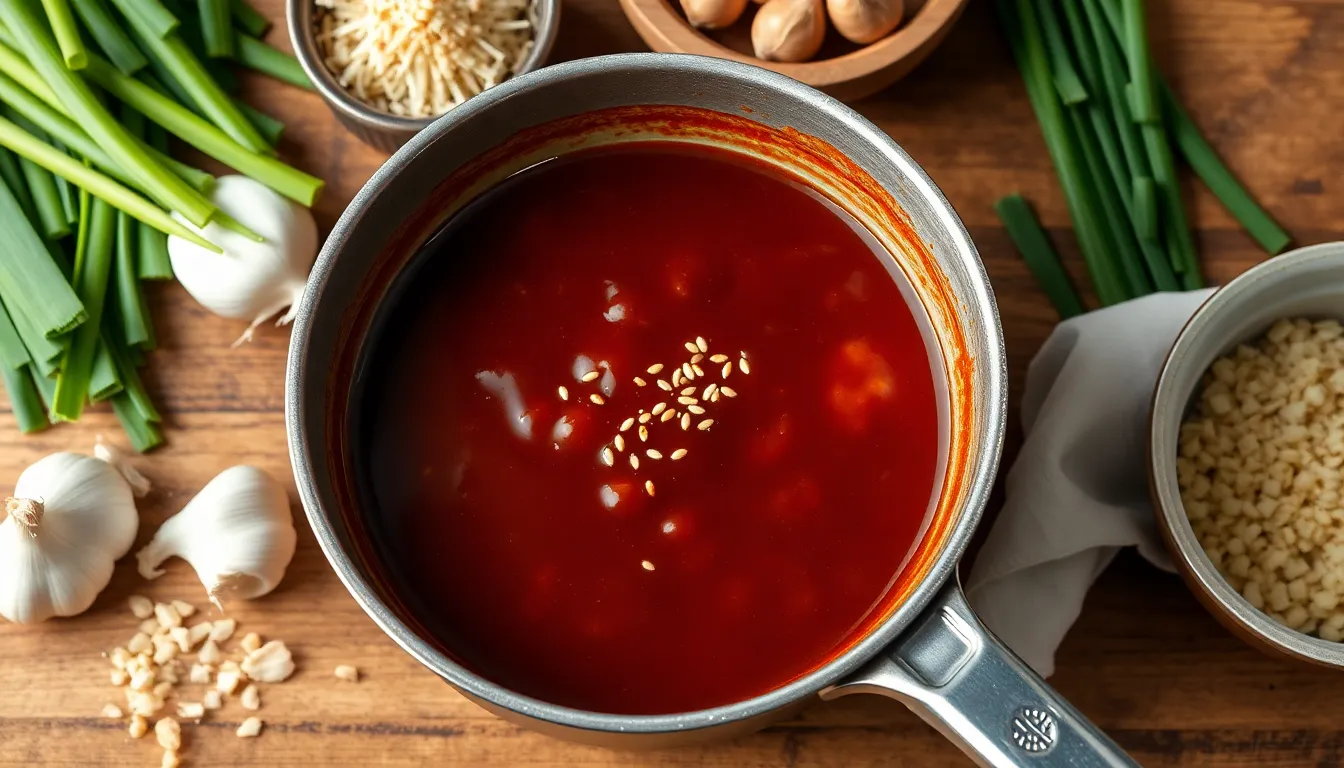
We’ll walk you through each step to create this flavorful Korean BBQ sauce in just 10 minutes. The process involves three simple stages that build layers of authentic taste.
Prep the Ingredients
We start by gathering all our ingredients to ensure smooth cooking. Mince 2-4 garlic cloves finely and grate 2 teaspoons of fresh ginger using a microplane or fine grater. Measure out 1 cup of soy sauce (preferably low sodium) and ¾ cup of dark brown sugar or ¼ cup if using light brown sugar.
Create a slurry by whisking 1 tablespoon of cornstarch with 2 tablespoons of water in a small bowl until completely dissolved. This step prevents lumps from forming in our sauce. Set aside 1 tablespoon of gochujang, 1-2 teaspoons of toasted sesame oil, and 1-1½ tablespoons of rice vinegar. If using optional ingredients like grated Asian pear or green onions, prepare these now as well.
Mix the Sauce
We begin by adding the cornstarch slurry to a medium saucepan and whisking it smooth. Pour in the soy sauce, brown sugar, minced garlic, grated ginger, rice vinegar, gochujang, and sesame oil. Whisk all ingredients together until well combined.
Bring the mixture to a boil over medium heat while stirring frequently. Once boiling, reduce heat to maintain a gentle simmer. Continue stirring for 3-5 minutes until the sauce thickens to your desired consistency. The sauce should coat the back of a spoon when ready. Remove from heat and let it cool slightly to allow the flavors to meld together.
Adjust Seasoning to Taste
We taste the cooled sauce and make adjustments based on our preference. Add more brown sugar or maple syrup if we want additional sweetness. Increase the gochujang or add red pepper flakes for extra heat and spice.
Balance the acidity by incorporating more rice vinegar if needed. Enhance the aromatic profile by adding fresh minced garlic or ginger. Adjust saltiness carefully by adding more soy sauce, keeping in mind its high sodium content. The sauce should achieve a perfect balance of sweet, savory, spicy, and tangy flavors that define authentic Korean BBQ sauce.
Directions for Use
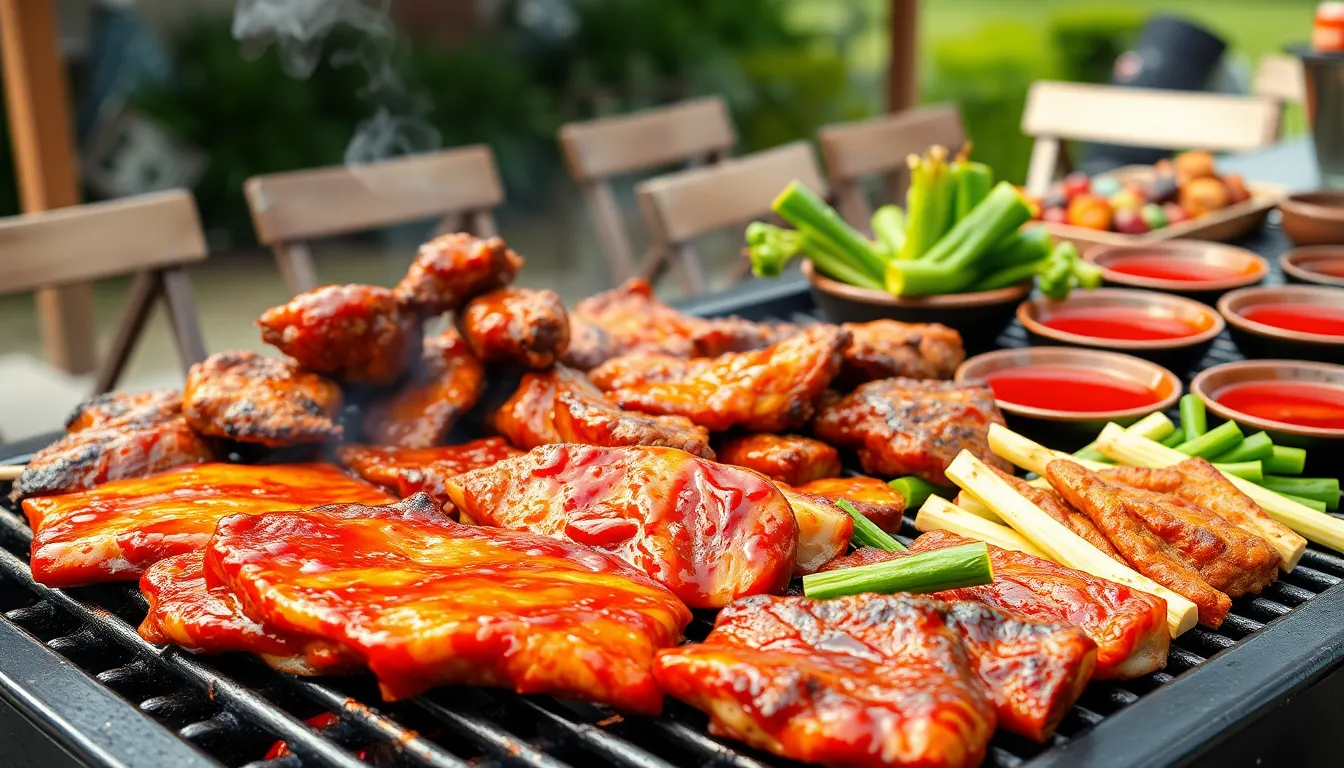
Our Korean BBQ sauce transforms into three distinct culinary tools depending on how we apply it. The versatility of this sauce makes it perfect for improving meats and vegetables through marinating, dipping, or glazing techniques.
As a Marinade
We coat beef, pork, chicken, or vegetables thoroughly with our Korean BBQ sauce before grilling or broiling. The marinade requires at least 30 minutes to penetrate the surface, though we recommend marinating for several hours or overnight for maximum flavor development.
Our sauce’s sugar content becomes particularly valuable during this process as it caramelizes beautifully when exposed to high heat. This caramelization develops rich, smoky flavors that define authentic Korean BBQ. We find that thicker cuts of meat benefit from longer marinating times, while delicate proteins like chicken thighs or seafood need only brief exposure to avoid overpowering their natural taste.
As a Dipping Sauce
We serve our Korean BBQ sauce warm or at room temperature alongside freshly cooked grilled meats, seafood, and vegetables. The sauce’s balanced profile of sweet, salty, spicy, and umami elements makes each bite more flavorful and satisfying.
Beyond traditional BBQ applications, we use this sauce to complement Korean pancakes, fried foods, and steamed buns. The thick consistency clings well to food without dripping, making it ideal for table service. We often place small bowls of the sauce at each place setting, allowing diners to control their preferred sauce-to-food ratio.
As a Glaze
We brush our thickened Korean BBQ sauce onto grilled or roasted meat during the final stages of cooking. The sauce’s consistency allows it to cling effectively, creating a glossy, appetizing coating that seals in moisture and flavor.
Multiple applications during cooking build layers of complex flavor while developing appealing caramelization. We typically apply the first coat about 5 minutes before the meat finishes cooking, then add a final layer just before serving. This technique prevents burning while ensuring maximum flavor impact and visual appeal.
Storage Instructions
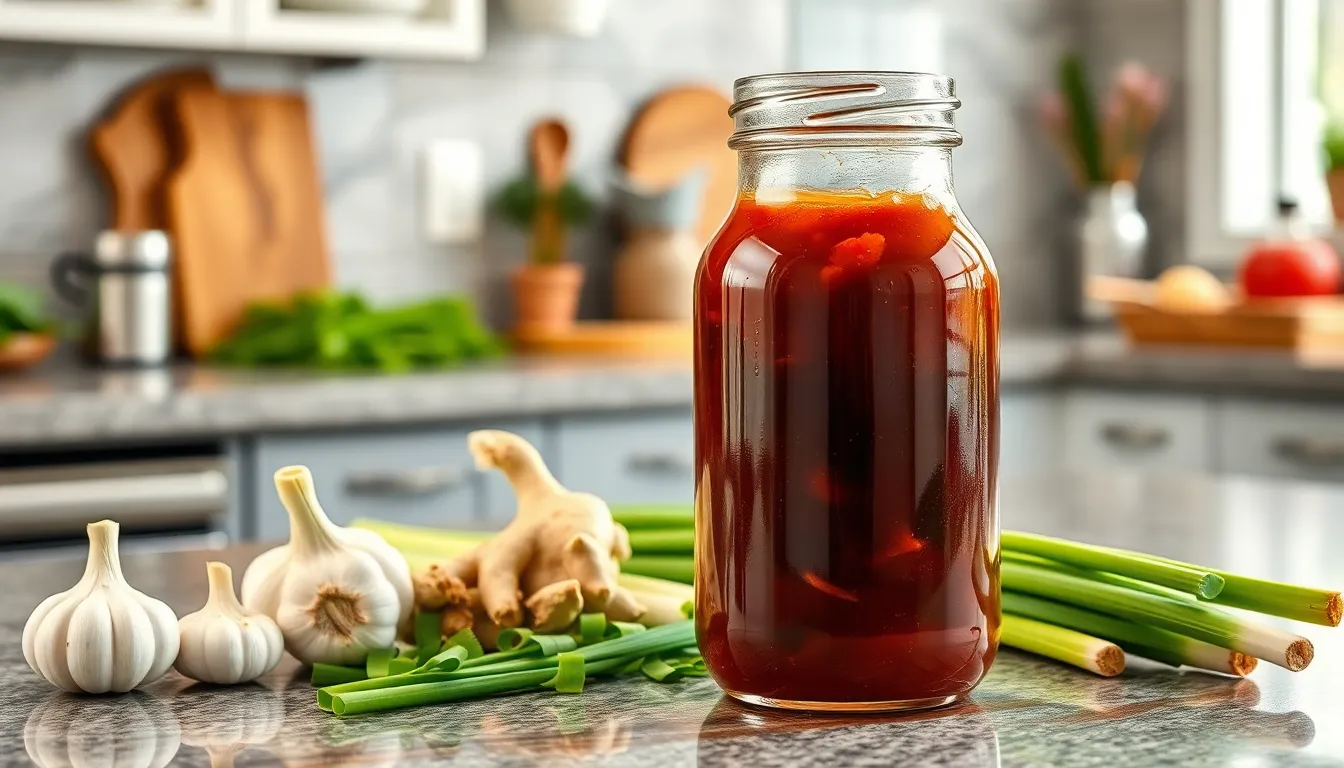
Proper storage keeps our homemade Korean BBQ sauce fresh and flavorful for future use. We recommend allowing the sauce to cool completely to room temperature before transferring it to storage containers. This cooling process prevents condensation from forming inside the container which could dilute the sauce or promote bacterial growth.
Transfer the cooled sauce into an airtight container or glass jar with a secure lid. Glass jars work exceptionally well because they don’t absorb flavors or odors and provide an excellent seal. We prefer using containers that hold just the right amount for our typical usage to minimize air exposure each time we open them.
Refrigerate the sauce immediately after sealing the container. Our Korean BBQ sauce maintains its quality and safety when stored in the refrigerator for up to 1 to 2 weeks. Most recipes suggest consuming the sauce within 1 week for optimal freshness though some variations can last up to 2 weeks when properly stored.
| Storage Method | Duration | Container Type |
|---|---|---|
| Refrigerated | 1-2 weeks | Airtight glass jar or container |
| Room temperature | Not recommended | N/A |
| Frozen | Not recommended | N/A |
Freezing this sauce is not advisable as it can significantly alter the texture and consistency. The cornstarch thickener and other ingredients don’t freeze well and may separate or become grainy when thawed. We find that the fresh preparation time is so minimal that making small batches as needed works better than attempting long term frozen storage.
Always use clean utensils when removing sauce from the container to prevent contamination. Check the sauce before each use for any signs of spoilage such as off odors, mold, or unusual texture changes. Fresh Korean BBQ sauce should maintain its glossy appearance and balanced aroma throughout its storage period.
Make-Ahead Tips

We love preparing our Korean BBQ sauce in advance because it saves precious time during busy weekdays and lets the flavors develop beautifully. Making this sauce ahead transforms meal planning into a simple process that delivers restaurant quality results at home.
Batch Preparation Strategy
We recommend doubling or tripling our recipe when making Korean BBQ sauce since the effort remains minimal while maximizing our cooking efficiency. Large batches provide enough sauce for multiple meals throughout the week. Preparing sauce in advance allows us to marinate proteins overnight for deeper flavor penetration.
Storage Timeline and Methods
| Storage Method | Duration | Best Uses |
|---|---|---|
| Refrigerator (airtight container) | 1 week | Daily cooking and marinades |
| Freezer (freezer-safe container) | 1 month | Long-term storage |
| Portioned ice cube trays | 1 month | Single-serve portions |
Our homemade sauce maintains peak flavor quality during the first week of refrigeration. Freezing extends storage life up to one month without compromising taste. We prefer portioning the sauce into ice cube trays before freezing to create convenient single-serve portions that thaw quickly.
Meal Planning Integration
Sunday meal prep becomes effortless when we prepare Korean BBQ sauce alongside other weekly cooking tasks. Marinating proteins in the sauce overnight develops complex flavors that rival professional Korean restaurants. We often prepare marinades on Sunday evening for Tuesday or Wednesday dinners to allow maximum flavor development.
Advanced Preparation Techniques
Slow cooker enthusiasts can combine our sauce directly with proteins like pork ribs for hands-off cooking that infuses deep flavors during the cooking process. We sometimes prepare multiple sauce variations simultaneously to accommodate different spice preferences within our household. Doubling the cornstarch slurry ensures proper thickening when scaling up recipes for larger batches.
Quality Maintenance Tips
Always use clean utensils when removing sauce from storage containers to prevent contamination that shortens shelf life. We label containers with preparation dates to track freshness and ensure optimal flavor quality. Room temperature sauce integrates more easily with cold marinades compared to using sauce straight from refrigeration.
Serving Suggestions
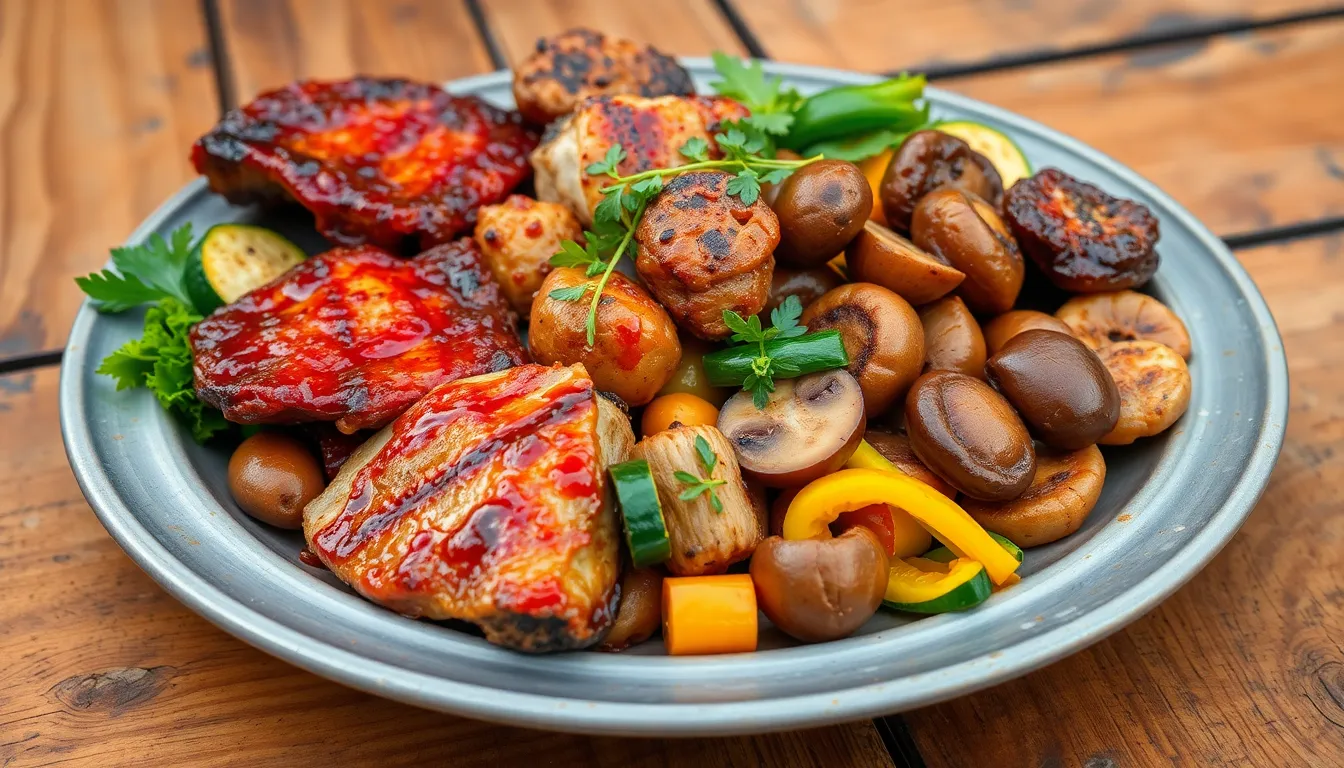
Our Korean BBQ sauce transforms ordinary meals into extraordinary culinary experiences with its versatile applications. We recommend using this sauce as a marinade for pork, chicken, beef, and salmon to infuse deep flavors into your proteins. The sauce works particularly well with pork ribs and chicken thighs when marinated overnight.
Grilled vegetables become irresistible when brushed with our Korean BBQ sauce during cooking. We suggest applying the sauce to zucchini, bell peppers, eggplant, and mushrooms for a sweet and savory glaze that caramelizes beautifully over high heat.
Traditional Korean BBQ dishes shine when paired with this sauce. We use it as a dipping sauce alongside grilled bulgogi, galbi, and Korean-style pork belly. The sauce also complements Korean pancakes and fried items perfectly.
Creative fusion applications expand the sauce’s versatility beyond traditional Korean cuisine. We drizzle it over burgers and sandwiches for an umami-rich flavor boost. Tacos filled with grilled meats benefit from a generous spoonful of this sauce as a condiment.
Slow cooker enthusiasts will appreciate how our Korean BBQ sauce creates tender, flavorful ribs with minimal effort. We add the sauce directly to the slow cooker with pork or beef ribs for fall-off-the-bone results.
Stir-fries gain complexity when we incorporate this sauce during the final cooking stages. The sauce coats vegetables and proteins evenly while adding depth to simple weeknight dinners.
Roasted vegetable medleys benefit from a light coating of Korean BBQ sauce before entering the oven. We brush root vegetables like carrots, sweet potatoes, and Brussels sprouts with the sauce for caramelized edges and enhanced flavor.
Seafood preparations welcome this sauce as both a marinade and finishing glaze. We brush salmon fillets with the sauce during grilling or baking for a glossy, flavorful crust that pairs beautifully with steamed rice.
Recipe Variations
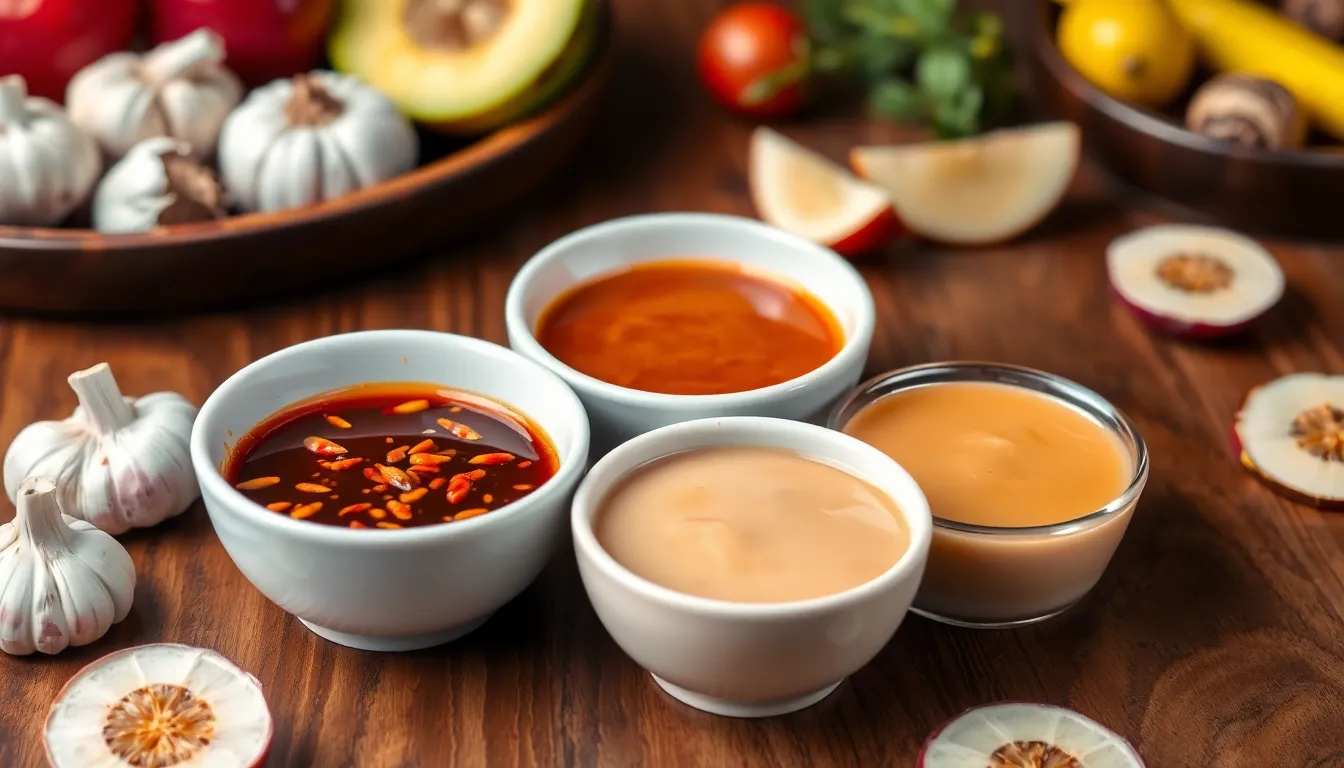
We’ve developed three distinct variations of our Korean BBQ sauce to accommodate different flavor preferences and dietary needs. Each variation builds upon our foundational recipe while offering unique characteristics that transform the sauce’s personality.
Spicy Korean BBQ Sauce
Fire lovers will appreciate this bold version that amplifies the heat without overwhelming the balanced flavor profile. We increase the gochujang from 1 tablespoon to 2-3 tablespoons depending on your heat tolerance. Korean chili powder (gochugaru) adds another layer of complex spice when sprinkled in at 1 teaspoon. For those without gochujang we substitute sriracha or red pepper flakes as alternatives though the flavor profile shifts slightly. The key lies in balancing the increased heat with additional brown sugar or honey to prevent the spice from dominating. This variation pairs exceptionally well with fatty cuts of pork and robust beef that can stand up to the intense flavors.
Sweet Korean BBQ Sauce
Our sweet variation caters to those who prefer mellower flavors with pronounced sweetness that complements rather than competes with grilled meats. We double the brown sugar from 2 tablespoons to 4 tablespoons and add 2 tablespoons of honey for complexity. Grated Asian pear or apple puree introduces natural fruit sugars that create depth beyond simple sweetness. Sweet rice syrup or mirin can replace some of the honey for authentic Korean flavor notes. This version works beautifully with chicken and pork while the fruit elements help tenderize proteins during marinating. The increased sweetness creates exceptional caramelization when used as a glaze making it perfect for weekend barbecues.
Low-Sodium Version
Health-conscious cooks can enjoy all the umami richness of Korean BBQ sauce while significantly reducing sodium content. We substitute regular soy sauce with low-sodium soy sauce maintaining the same measurements to preserve the sauce’s consistency. The reduced salt allows other flavors to shine more prominently so we often increase the rice vinegar slightly to enhance the tangy notes. Garlic and ginger become more pronounced in this version creating a cleaner flavor profile. This variation proves that dietary restrictions don’t require flavor sacrifices and works particularly well for those monitoring their salt intake without compromising the authentic Korean taste experience.
Conclusion
We’ve shown you how easy it is to create restaurant-quality Korean BBQ sauce right in your own kitchen. With just a handful of pantry staples and 10 minutes of your time you can unlock the bold flavors that make Korean cuisine so irresistible.
This homemade sauce gives you complete control over taste and quality while saving money compared to store-bought alternatives. Whether you’re planning a weekend BBQ or looking to spice up your weeknight dinners this versatile sauce delivers every time.
Now it’s time to fire up your grill grab your favorite proteins and experience the magic of authentic Korean BBQ flavors. Your taste buds will thank you for taking this delicious journey into Korean cooking.
Frequently Asked Questions
What ingredients do I need to make Korean BBQ sauce at home?
You’ll need soy sauce, brown sugar, rice vinegar, sesame oil, garlic, ginger, gochujang, honey, cornstarch, and water as the base ingredients. Optional enhancements include grated Asian pear, green onions, toasted sesame seeds, black pepper, mirin, and red pepper flakes. All ingredients are commonly found in most pantries or grocery stores.
How long does it take to make Korean BBQ sauce?
The entire process takes just 10 minutes. This includes prepping ingredients like mincing garlic and grating ginger, mixing everything in a saucepan, bringing it to a boil, and simmering until thickened. It’s a quick and easy recipe perfect for busy weeknights.
What kitchen equipment do I need to make this sauce?
You’ll need basic kitchen tools: a medium saucepan, whisk or wooden spoon, measuring cups and spoons, a sharp knife and cutting board for prep work, a small mixing bowl for cornstarch slurry, and an airtight container for storage. No specialty equipment required.
How should I store homemade Korean BBQ sauce?
Cool the sauce completely before transferring to an airtight container or glass jar. Store in the refrigerator for 1-2 weeks, with optimal freshness in the first week. Always use clean utensils to prevent contamination. Freezing isn’t recommended as it may change the texture.
What are the different ways to use Korean BBQ sauce?
The sauce is incredibly versatile – use it as a marinade for meats and vegetables, a dipping sauce for grilled foods and Korean pancakes, or brush it on as a glaze during cooking. It works great with pork, chicken, beef, salmon, and even in stir-fries and fusion dishes.
Can I make Korean BBQ sauce ahead of time?
Yes! Making it ahead actually enhances flavor development. You can double or triple the recipe for batch preparation. The sauce keeps well in the refrigerator for a week or can be frozen for up to one month. Consider portioning into ice cube trays for convenient single servings.
Are there different variations of Korean BBQ sauce?
The article features three variations: Spicy Korean BBQ Sauce with increased gochujang for heat lovers, Sweet Korean BBQ Sauce with doubled brown sugar for caramelization, and a Low-Sodium Version using reduced-sodium soy sauce for health-conscious cooks. Each caters to different taste preferences and dietary needs.
How long should I marinate meat with Korean BBQ sauce?
For optimal flavor development, marinate proteins overnight when possible. Pork ribs and chicken thighs benefit especially from longer marinating times. Even shorter marinating periods of 2-4 hours will still enhance the meat’s flavor significantly, making it perfect for last-minute meal planning.

